CHAPTER SIX
Canada: A Minister's Wife
(More excerpts from Marianne's Story by Iris Owen and
Pauline Mitchell.
Marianne continues her story about moving to Canada.)

"I went to Canada, stayed nearly a month, then went through
a ceremony of marriage with Lionel. Canon Smithers officiated, and after
the ceremony Lionel bragged about christening me. Dr. Smithers said the
marriage was legal in law, but void in the Church's eyes - by reason of
spiritual relationship.
Historical records of New Brunswick
from the collection of Rev. and Mrs. Lionel Foyster
"We went to Long Lake for a vacation or honeymoon. We had sunshine,
swimming, and canoeing. We played chess, and ate three good meals [a day].
Four days soon went, and we went back to Salmonhurst, where we found a
lovely meal, and a quiet house awaiting us.
"We found also much mail and newspapers. Lion had a sermon to
prepare, and I unpacked. Next day we attended three services in the three
churches of L's parish. We ate too much, because the Danes were hospitable
and good cooks. We were very happy, and life was good. The rectory was
not too big - it had beautiful hardwood floors, a chemical toilet, and
an outside [water] pump.
"We returned to the old country for a vacation in 1924. We had
a ball - we stayed with all [of] Lion's folks, and later went to my folks
for a visit. Three months passed too quickly and we had to go back to Salmonhurst.
Once on shipboard we were very glad to go home.
"Lion had a bout of bronchitis, but not too bad, and before
we knew it we were home at Salmonhurst. SURPRISE - during our absence the
people had put a new furnace under the house for us. We were truly home.
We were glad to have this wonderful addition to the house because New Brunswick
winters were very cold. But hearts were warm.
"That winter Lion produced a really nice children's operetta
and everyone pitched in to make costumes. Lion worked like a dog - he was
a good cleric - and never spared himself. If he had stayed home in cold
weather it would have been better for him. [I am convinced the wonderful
stories Mom told me about her "father" and being raised in Maine
were based on Lionel and their time together in Canada.]
"The next summer [1925 - Lionel would be 46] we went to Prince Edward Island
for a vacation. And then Lion had a heart attack while swimming - mild,
but enough to warrant no more water sport. That winter he had a sudden
onset of arthritis. Life wasn't so good after that. He knew we had to have
lighter work, and began to enquire about a new parish. I had learned to
read and speak Danish, and never wanted to leave. I never liked towns much
- I still don't. But leave we did, and went to Sackville New Brunswick.
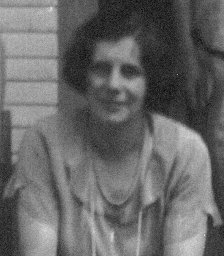 "Sackville at that time was a quaint little college town - calm, unhurried,
and definitely respectable in a prim Old World way - to the church the
sidewalks were wooden at that time. It was a very nice town with just the
right number of stones (houses) and with some really beautiful houses.
A country club and a ladies college gave luster to the city, fortunate
enough to have Mt. Allison University and a business academy. It also had
two foundries to add substance to its economy. All the best people knew
each other, which made for close-knit relations.
"Sackville at that time was a quaint little college town - calm, unhurried,
and definitely respectable in a prim Old World way - to the church the
sidewalks were wooden at that time. It was a very nice town with just the
right number of stones (houses) and with some really beautiful houses.
A country club and a ladies college gave luster to the city, fortunate
enough to have Mt. Allison University and a business academy. It also had
two foundries to add substance to its economy. All the best people knew
each other, which made for close-knit relations.
"[The town] expected tradition from its professionals. The Reverend
Wiggins, the former Episcopal pastor, had given years of faithful service.
Beautiful service by a dedicated man. Now a new man was in the pulpit -
a man with liberal high church traditions. It was difficult going, and
Lion did not help it much by setting a high priority on visiting the lower
class people. I didn't help much. I was very suspect because I was too
young.
"My predecessor, Mrs. Wiggins, was everything I am not. Grey
haired, calm, a veteran in church work. She was a dear, beautiful person,
who was kind and good.
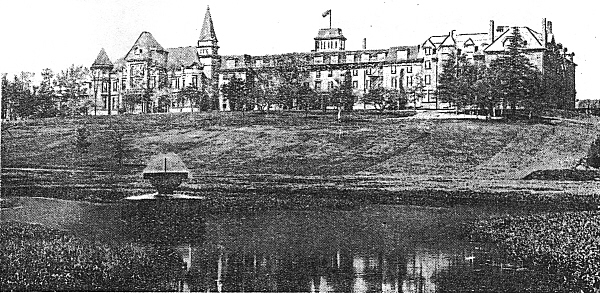
"I took courses at Mt. Allison, and then my brother Geoffrey
came to stay for a whole year. He obtained a job at the foundry
and was soon singing in the choir, and entered into many church activities.
I was glad to have Geoffrey [present] because Lion had the lower church
to take care of, in addition to the parish church, which, combined with
all the other activities and visiting, kept him very busy. He also was
not in the best of health, which slowed him up somewhat. This troubled
him, and caused him to do more than he should in order to prove he was
alright. We both missed our Salmonhurst connections.
"Geoffrey had his tonsils out and somehow or other this made
him long for home. Even his paintings did not satisfy him any more and
he left, and we missed him. I missed being able to chat with him.
"I developed polyps in the uterus and bled often, so I was told
to have them removed, which I did at Amherst hospital. By the way, the
hospital caught fire, and I was sent home two days after the operation!
Mrs. Wiggins was so sweet, she came and fixed me a lovely tray.
"Lion began to drill the choir, and introduced Marback's Communion
Service. The organist left, and a less experienced organist took over.
Lion was beginning to loose sleep at night due to pain. He feared cancer,
since his mother had suffered this malignancy. He refused to consult a
medical doctor until it was nearly too late. He had fallen victim of arthritis
deformans. On advice of his doctor he began to think of going to an English
hospital, and with this in mind he settled on St. Luke's Hospital in London.
"Just around this time [1928] a tragic thing happened in Westcock;
a man named Tower fell off a load of hay and was killed. He left behind
several children, the youngest a little girl just a few months of age.
The mother had died just previously of a brain tumour. We were asked to
take the little girl, and did so. She was blond and Nordic. We had an old
photograph of Lion's mother as a little girl, and we added Adelaide to
her name of Barbara."
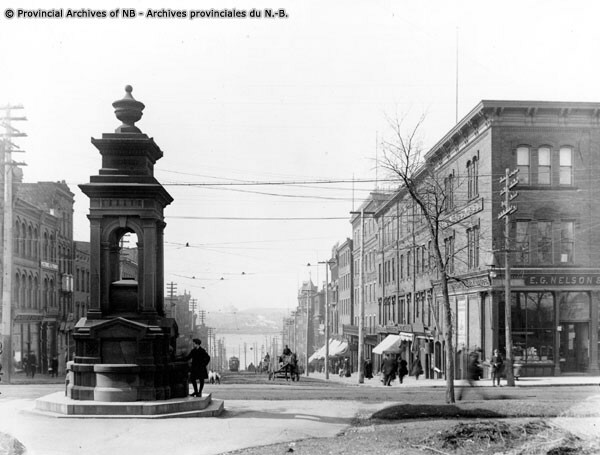
Marianne goes on to relate how while Lionel [was at] St. Luke's Hospital,
she [lived] in an apartment in St. John. She tells us how her son Ian came
over from Belfast to keep her company while Lionel was [in the] hospital
in England. She says, "Lion thought it would be company for me to
have Ian on his vacation. Lion had previously met Ian when we were home
in '26. So Ian arrived just before we went to St. John. Lion and he horrified
the neighbors by climbing out to the flat roof to view the city."
[Marianne told a private detective in 1958 she informed Lionel that
Ian was her brother, "which was the biggest mistake she made. Thereafter
she had to continue to lie." She told the investigator Lionel did
not know she was previously married, but she claimed it "would have
been better if she had told him."(1)
]
She goes on to tell us that Ian suffered a ruptured appendix at this
time, and so Adelaide was taken care of by a dear friend, Maren Johansen
of Salmonhurst. [In her Service Prayer Book that I found among her
papers, Mom listed her "stepmother" as "Maren Fischer."]
Marianne found a job, and left Adelaide for the winter with her friend,
while Ian attended the local school, St. Josephs. Marianne says, "He
was really a good student - the fees were not too high, and he received
a scholarship."
She then goes on to tell us:
"Time passed and Lion returned to Canada - lame and not much
better than when he left. We went to Salmonhurst, retrieved Adelaide, and
[went] to England, where Lion had the opportunity to become rector at Borley.
He realized [there would be] no more Canadian winters for him, no more
fighting the elements. I guess we both hated this part, for Canada had
been good to us. We both worried about returning to a land we both knew
had changed so much. Ian wanted to stay at St. Josephs until his term was
out.
"We sailed away to England after spending some time in Salmonhurst.
We adopted Adelaide legally [there] through Anders J. Jensen."(2)
(The following are chapter outlines for Marianne's unpublished
autobiography.)
The Canadian Parishes and Lion

Bay Du Vin on the winter was entirely cut off from the world. It
was a village of north shore fishermen. Anglicanism was traditional, since
English had been their ancestors. They were not spiritual and very sinful
sexually (Lion's version). Actually, they were typical peasants.
Gordon and Lorne was on the Tobique and consisted of several churches.
Lion had to be on the go for weeks at a time. Sandwiched in with Presbyterians,
Holy Rollers, and Roman Catholics, he made no headway though he worked
very hard.
New Denmark, or Salmonhurst, or Drummond, call it what you will,
it was Danish for the most part, and the rest was made up of destitute
English emigrants, a foreign belt out in the new lands, and a scattering
of the French. It was sandwiched in between French settlements and was
a wonderful place to live.
The people were gay, hardworking, and full of life. They were Anglicans
because of an accident. They came out to the country as emigrants and when
a death occurred, they sought a priest to bury the dead. The man was an
Anglican who persuaded the bishop to license a Dane as a lay reader. The
man was a schoolmaster and helped the bishop translate the Book of Common
Prayer into Danish. Later a Dane was ordained a priest, and so it continued
Anglican.
But the Danes were Anglican in name only. They kept the traditional
vestments and ceremonies of the Formal Lutherans of old Denmark. None of
the milk and water stuff of American Lutheranism. ["America"
here must be taken to mean North America. It must also be remembered this
was written in the late 1950s, after she had lived in the States quite
some time.]
This was it. I had the time of my life. I learnt Danish. I learnt
to cook, to sew, to ski, to skate, to dance, and we nearly sang our heads
off. Lion was respected by the Danes and he respected them; neither loved
the other.
Sackville was a university town - a Methodist University. Lion went
expecting another Cambridge, or Oxford. He had a surprise. Methodism reigned.
Anglicanism was just a sect. Lion tried to bring the gospel to the poor
and to the outlying section of the parish. This caused anger in the hearts
of the four families who ruled the parish. They did not want the poor in
the church. What they had in mind was a sort of comfortable chapel with
a comfortable chaplain.
I went to college there and took up youth work in a big way. I had
a maid and extra help, because that was how it had to be. I was glad to
go to Mt. Allison [University] and was happy. Lion hated Sackville. He
hated the nouveau riche folk who tried to patronize him and put themselves
on a level. Most of all he hated Methodism.
His rheumatism came on him with increased vigor and he went to England
to Guys Hospital and to St. Lukes Hospital. I remained in Canada to continue
my education. Lion felt that I should take the chance when I had it, and
I agreed, since there was no reason for me to go and live in London, even
if we could have afforded it.
When he returned, we went to live in New Denmark for the summer,
and Lion thought once or twice of going out to British Columbia to live,
but he felt that he could not get on with the British Colombians. He had
been there and felt he knew what he was talking about.
We discussed going to Ireland, but Lion felt he could not accept
the Irish Church which he felt had no authority. I did not understand,
but I agreed with him, if he did not want to go there was no reason. While
in the state of transition, Lion lost most of his money and Borley was
offered to him for the second time.
The Decision
In which we make the decision to leave Canada and to return to Great
Britain. We weighed the reasons for going against the desires to remain
in the New World. We had so much to keep us in America; there were so many
churches without pastors in Canada; I had found love, friendship and education.
On the other hand, Lion had been told that he could not undertake
country mission work again. He had arthritis and had had one heart attack
while we were vacationing on Prince Edward Island. He was unwilling to
live in a city, and when Borley was offered to him for the second time,
we both realized that it was an ideal spot for a sick man. We knew that
he would go to the parish with a reputation. His uncle and cousin had both
been rectors of Borley and had held the parish for over seventy years.
We both realized that it would be a new life. We would not have the free
and easy friendship of parishioners and friends. We knew that England had
a different code of life and we knew the caste system was very strong.
On the other hand, Lion placed the fact that as far as he knew, there
had been no missionary work done in the parish. He described both his uncle
and his cousin, Henry and Harry Bull, as conventional church men. He went
into detail of how he would establish a parish run on the lines of a Canadian
parish and bring American ideals of democracy into the parish. He painted
a beautiful picture of the English countryside, and we both planned the
pastoral plays we would produce. Not only pastoral plays, but indoor plays,
Miracle plays - and I was in high feather at the thought of all the theatrical
costumes I would get the chance to make. He had done such fine work in
Canada with play producing in the parishes, and I had a hay day making
the costumes.
So with mingled feelings of sorrow at parting from our many friends,
we looked forward to Borley with confidence.(3)
The Amherst connection
Iris Owen wrote that Marianne made no secret that "both she and
Lionel were very familiar with the Amherst story," while in Canada.
Amherst was where Marianne had a uterine operation that left her sterile.
In 1879, Walter Hubbell chronicled a six week stay in a haunted house located
in that same town. Phenomena there included wall writings and flying articles,
as well as mysterious appearances and disappearances. The events swirled
around 18 year old Esther Cox. Several authors, including Hall, drew comparisons
between Amherst and Borley.
In about 1928, Foyster lost a great deal of money. Probably in bad stocks.
I remember seeing stocks in Canadian oil in my mothers hidden papers. These
must have been worthless to them.
Hall's research, continued
The following excerpts are from Trevor Hall's unpublished manuscript
and contain Ian Shaw's recollections. Shaw contacted Hall after reading
The Haunting of Borley Rectory which Hall co-authored. After much
intrigue, Shaw met all three of the authors and told everything he could
remember about his mother. Hall thought Shaw looked very much like his
mother as she appeared in the famous photo at Borley holding a baby. At
age 42 he was thin and of medium height, with gray hair. He did not appear
to be healthy. His attitude toward his mother was described as "one
of contempt and dislike." Hall described him as a "very odd character"
and therefore tried to verify his story wherever possible, although not
all details could be verified. Hall wrote:
In 1922 Salmonhurst was a remotely situated village, being a centre
for the forests and lumber camps where Mr. Foyster carried out his work.
Mr. Foyster was away from home a great deal of the time. According to information
given to Shaw by a Mrs. May Johansen and a Mrs. Adelie Hansen when he went
out to Canada, alleged phenomena developed at Salmonhurst Rectory when
Marianne went to live there. She maintained that she heard strange and
violent noises in the house and was once pushed out of her chair by an
invisible force. It was said that Mr. Foyster was once awakened from sleep
by a cold bony hand touching him.
Before long scandal occurred at Salmonhurst involving Marianne and
a young clergyman named Hall, who used to stay at the rectory whilst Mr.
Foyster was away. Mr. Foyster steadfastly refused to believe any story
to his wife's discredit, maintaining that her high spirits and kindness
were misunderstood by her detractors. This view was evidently not shared
by the Bishop of Fredericton, in whose diocese Mr. Foyster worked, and
it was Marianne's escapades which ultimately resulted in Mr. Foyster having
to leave Canada in 1930.
Marianne was not popular in New Brunswick. She made a very favourable
impression upon people at first due to her good looks and attractive personality,
but her inability to speak the truth soon involved her in difficulties
in a small community, where she was quickly found out.
In 1928, for example, Mr. Foyster had returned to England for a few
weeks to try unsuccessfully to obtain a parish and Marianne and Shaw had
remained behind in Canada. . . One day they were out in Mr. Foyster's car
when a slight collision occurred with the car of a Major Forbes-Mitchell
of the government survey office. Marianne gave her name as Von Kiergraff
and introduced [Ian] as her brother, Geoffrey Von Kiergraff.
Marianne became friendly with Major Forbes-Mitchell and paid several
visits to his office and his house, taking Shaw with her on one occasion.
. .
The Major discovered. . .that the boy's name was Shaw. He informed
the police, and both Marianne and Shaw were interviewed. Marianne was not
charged, but Major Forbes-Mitchell demanded and received back a number
of presents he had given to Marianne and the affair ended abruptly and
unpleasantly. . .
On another occasion, Shaw said, Marianne had been coming home by
sea to Ireland on leave from Canada. She . . . gave her name as "Benoni."
. . . Marianne received a letter from her mother begging her to stop these
pointless untruths.
According to Shaw, Marianne was an exhibitionist. At a public dinner.
. . the governor [said an escaped prisoner] would receive a flogging
if and when he was caught. Marianne gave a piercing shriek and fainted.
Shaw said that he was sure this was assumed, merely to call attention to
herself.
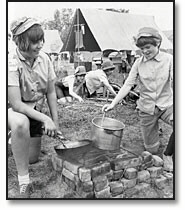 Shortly after Marianne came to Canada she became interested in the
Girl Guide movement. As the wife of the priest she claimed a portion of
prestige amongst the few women officers of the local troop, and was made
second in command. Before long she had usurped the position of commanding
officer by filling it herself. In six months the whole troop was disbanded
due to lack of support. [When I was approximately the same age - my
early twenties - I became president of a college service fraternity. I
soon ran it like my own private club. My overbearing attitude was recognized
by those around me as simply the excess of youth.]
Shortly after Marianne came to Canada she became interested in the
Girl Guide movement. As the wife of the priest she claimed a portion of
prestige amongst the few women officers of the local troop, and was made
second in command. Before long she had usurped the position of commanding
officer by filling it herself. In six months the whole troop was disbanded
due to lack of support. [When I was approximately the same age - my
early twenties - I became president of a college service fraternity. I
soon ran it like my own private club. My overbearing attitude was recognized
by those around me as simply the excess of youth.]
Shaw said that Marianne was not an accomplished French linguist.
She had the usual school French at her command. . .She was constantly taking
up new languages. She would buy a Spanish tutorial grammar and study it
for five or six weeks and then abandon it. Six months later she would take
up Dutch or Portuguese. [She was always trying to master French, and
had manuals lying about through the very end.]
Marianne had a large number of affairs with men in Canada to the
increasing displeasure of the Bishop of Fredericton. On one occasion, said
Shaw, she tried to commit suicide by drinking Lysol after an unfortunate
liaison. A Roman Catholic priest. . .managed to get her into a . . . hospital
under the pretense that the attempted suicide was an accident. The affair
was hushed up.. .
After Mrs. Foyster's vain attempt to take a living in England, he
returned to Canada and became rector of Sackville, New Brunswick, an appointment
which he held for only two years. . . Salmonhurst Rectory, where the Foysters
lived, was in the main street opposite the entrance to [Mt. Allison] University.
Soon after the family began their period of residence at Sackville,
mysterious footsteps and other auditory phenomena were heard by Marianne.
The rumour that the rectory was haunted became fairly widespread and one
parishioner went so far as to consult the previous incumbent, Rev. Follet,
who said that he had no reason to believe that anything untoward had occurred
whilst he lived there.
In Sackville the inevitable scandals began to surround Marianne
[sic]. According to Shaw, one of her principal lovers was a man with
the extraordinary name of Sarto Edmond Foley. . .[Shaw] remembered
one occasion when a fight occurred between Foley and another man over Marianne.
Shaw said that Marianne's Roman Catholicism developed in New Brunswick.
A priest named Father du Parc used to visit her, which scandalized the
Anglican community.
Shaw remembered Santiago Monk. . . [who] described himself
as [Marianne's] "spiritual godfather." The reader may
suspect that there was more in it than that [sic].
In Sackville there was a family named Niles, with eight or nine children.
The youngest was Adelaide Barbara Alice, and the mother died when she was
born. Six weeks later the father was accidentally killed. The Foysters
adopted Adelaide.(4)
Adelaide was born Barbara Alice Tower, not Niles. Mom added the name
Adelaide later. If Ian was confused about these facts, what others might
he be mistaken about? Ian was only 10 years old when he moved to Canada.
Years later, a private investigator talked to Marianne very briefly
about Canada. Using information supplied by Ian, the detective Robert Swanson
asked her if she got desperate because one of her flings went sour:
S. Your son also told us that you had tried to commit suicide
in Canada. . .
M. Oh, what an absolute lie. . .
S. . . .and that a friend of yours, Father Boyd, got you into
the hospital. Is that true?
M. I have not known in the whole of my life a priest by the name
of Boyd, and as to committing suicide, that is a downright lie.(5)

Marianne told Swanson in 1958 that Ian came to Canada "because
he suffered from asthma and it was thought that the air out there would
be good for him."(6) She also said
Ian "came out to us because he was getting kind of wild then. Oh,
high spirited and a little bit on the rough side, and we thought it would
do him good if he went to a good strict school. It did do him a lot of
good."(7) This could have been lifted
exactly from my own life almost 30 years later when my mother placed me
in a Catholic boarding school!
At Mt. Allison, Marianne took two terms of woodworking and drawing during
the 1927-28 school year. Perhaps she was the one who actually made the
two wooden boxes she gave to me and claimed her father made! One was simple
affair of cherry wood turned on a lathe. The other was a more complicated
work with elaborate inlays which she referred to as the "pioneer box." Perhaps she felt she was in
the wild frontier! I still have both.
Marianne also took some piano classes at Mt. Allison. In 1928-29, she
took a first year English class. The only grade I could find for any of
these classes was a "50" (passing) for the English course.
Back to England
The next stop for Marianne and Lionel Foyster was Borley Rectory, Essex,
England.
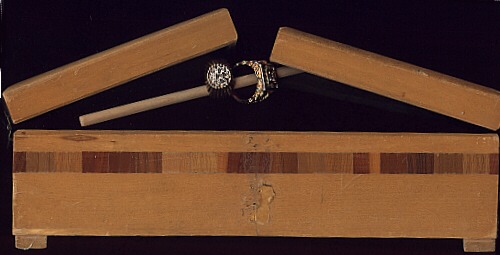
Chapter Seven
Table of Contents
1. Hall, Trevor. Marianne Foyster of Borley Rectory.
Unpublished, 1958. Vol. IV, p. 66.
2. Owen, Iris M., Mitchell, Pauline. Marianne's
Story. Toronto: New Horizons Research Foundation, 1979. pp. 30-33.
3. Hall, Trevor. Marianne Foyster of Borley Rectory.
Unpublished, 1958. Vol. V, appendix.
4. Ibid, Vol. II, pp. 8-17.
5. Ibid, Vol. V, p. 45.
6. Ibid, Vol. IV, p. 29.
7. Ibid, Vol. V, p. 43.
 "Sackville at that time was a quaint little college town - calm, unhurried,
and definitely respectable in a prim Old World way - to the church the
sidewalks were wooden at that time. It was a very nice town with just the
right number of stones (houses) and with some really beautiful houses.
A country club and a ladies college gave luster to the city, fortunate
enough to have Mt. Allison University and a business academy. It also had
two foundries to add substance to its economy. All the best people knew
each other, which made for close-knit relations.
"Sackville at that time was a quaint little college town - calm, unhurried,
and definitely respectable in a prim Old World way - to the church the
sidewalks were wooden at that time. It was a very nice town with just the
right number of stones (houses) and with some really beautiful houses.
A country club and a ladies college gave luster to the city, fortunate
enough to have Mt. Allison University and a business academy. It also had
two foundries to add substance to its economy. All the best people knew
each other, which made for close-knit relations. 





